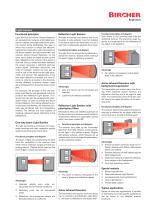
Excertos do catálogo

Light barriers Functional principles Reflection Light Barriers Light Barriers and Active Infrared Detectors are optoelectronic sensors which detect persons an objects using light without any physical contact being established. The way in which they function is simple but effective. Light Barriers respond to each interruption of the beam between the light transmitter and receiver. Active Infrared Detectors, on the other hand, detect an object as soon as the light reflected by the surface of the object is received. Once an object has been detected, the sensor generates a definded electrical output signal. Evaluation electronics and relay or transistor outputs are thus just as much a part of the sensor as the light transmitter and receiver. The applications of the two basic detection principles are very diverse. In order to do justice to this diversity, various different functional sensor types were developed from these two basic principles. The light transmitter and receiver are in one housing. A retro-reflector must be installed in the beam path of the transmitter in such a way that it is physically separate from these. For example, the principle of the one-waybeam Light Barrier was developed further to produce the Reflection Light Barrier. If required, this can also be equipped with polarisation filters. In order to prevent the Active Infrared Detector from being affected by environmental interference, the reflection principle was combined with the triangulation method. The devices are thus capable of masking undesired optical reflections in the background. One-way-beam Light Barriers The light transmitter and receiver are in separate housings with their respective optical systems pointing toward each other. Functional principles and diagram The beam of light only passes along the path from the transmitter to the receiver once which means extensive ranges and high operating reserve. Objects which interrupt the beam trigger a switching operation. Functional principles and diagram Each object in the scanning area trips the switching function. The scanning range depends, to a large extent, on the reflectance of the object to be detected. Functional principles and diagram The light from the transmitter is reflected towards the receiver. Objects which interrupt the beam trigger a switching operation. Only one device can be connected and installed Custom-built reflectors available Reflection Light Barriers with polarisation filters Polarisation filters are installed upstream of the transmitter and receiver optical systems. These filters define two polarisation planes which have been rotated 90°. ■ No reflector is necessary as the object itself is the reflector Active Infrared Detectors with background suppression The transmitter and receiver are in one housing. Their separate otpical systems are aligned so that they are at an angle to each other. The intersection point of the two optical axes is the upper boundary of the scanning area. Functional principles and diagram The receiver determines whether the beam it receives is reflected by an object within the scanning area or outside it (background). Functional principles and diagram The receiver only picks up the transmitter light from the triple reflector as this polarises the light in the desired manner. Objects with glossy surfaces, which likewise act as reflectors but do not change the polarisation, are thus detected reliably. Advantages ■ Almost constant scanning range for reflective objects with diffuse reflectances which vary greatly ■ Reliable detection of dark objects against light backgrounds ■ Insensitive towards undesired reflection from objects in the background ■ Very high operating reserve Special variants Advantage ■ The beam is cleanly interrupted in the case of glossy and reflective objects Operates reliably even under unfavourable environmental conditions Switching point can be reproduced easily Reflective, non-transparent objects are detected without any difficulty Active Infrared Detectors The transmitter and receiver are in one housing. In contrast to the Reflection Light Barrier, the beam is reflected by the object itself. Safety Light Barriers Data transmission Light Barriers Increased-safety type Light Barriers Laser Light Barriers Printed label readers Typical applications Variety of every-day applications. A number of interesting and type-specific applications can be found in our detailed product brochures.
Abrir o catálogo na página 1Todos os catálogos e folhetos técnicos BBC Bircher Smart Access
-
Safety mats
8 Páginas
-
S-Line
4 Páginas
-
PrimeMotion C
2 Páginas
-
RegloBeam 2
2 Páginas
-
EsGate 3
4 Páginas
-
EsGate 2
4 Páginas
-
ClickLine CoverLine StandardLine
8 Páginas
-
PrimeMotion B
2 Páginas
-
PIR 20
4 Páginas
-
PrimeTec A
4 Páginas
-
Herkules 2E
4 Páginas
-
ProLoop2
4 Páginas
-
ProAccess
4 Páginas
-
ExpertSystem XL
4 Páginas
-
Pressure Wave Switches
8 Páginas
-
EsMatix 3
2 Páginas
-
CleanSwitch
4 Páginas
-
LBDoor
4 Páginas
-
ProLoop Lite
4 Páginas
-
ArtMotion 2
2 Páginas
-
CleanSwitch
4 Páginas
-
CR3
2 Páginas
-
SpotScan
4 Páginas
-
EsMatix 3
2 Páginas
-
UniScan
4 Páginas
-
Sensorama 2019
8 Páginas
-
Passive Infrared
1 Páginas
-
Light Sensors
1 Páginas
-
ClickLine CoverLine StandardLine
8 Páginas
-
Merkur 2
6 Páginas
-
Brochure Safety Mats
8 Páginas
-
Sensorama 2014
8 Páginas
-
CareMat®
4 Páginas
-
New colors for safety mats
4 Páginas
-
TopScan
4 Páginas
-
PIR20
4 Páginas
-
PIR30
4 Páginas
-
ProLoop
4 Páginas
-
UniScan
4 Páginas
-
PrimeTec / PrimeScan / PrimeMotion B
4 Páginas
-
PrimeTec A / PrimeScan A
4 Páginas













































































